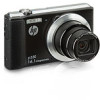HP p550 HP p550 Digital Camera - User Manual - Page 85
To view copied photos, After the copy operation is complete, drag the drive icon to Trash.
 |
View all HP p550 manuals
Add to My Manuals
Save this manual to your list of manuals |
Page 85 highlights
5. Power on the camera. The camera's back lamp will light green at this time. In this mode, your Macintosh recognizes the memory card loaded in the camera (or the camera's built-in memory if it does not have a memory card loaded) as a drive. The appearance of the drive icon depends on the Mac OS version you are using. • The first time you connect the camera to your Macintosh with the USB cable, an error message may appear on your computer. If this happens, disconnect and then reconnect the USB cable. • Charging continues even if the camera is turned on (page 19). 6. Double-click the camera's drive icon. 7. Drag the "DCIM" folder to the folder to which you want to copy it. 8. After the copy operation is complete, drag the drive icon to Trash. 9. On the camera, press [ON/OFF] (Power) to power off the camera. After making sure that the green back lamp is unlit, disconnect the camera from the computer. • To view copied photos 1. Double-click the camera's drive icon. 2. Double-click the "DCIM" folder to open it. 3. Double-click the folder that contains the photos you want to view. 4. Double-click the file you want to view. A photo that was rotated on the camera will be displayed on your Macintosh screen in its original (unrotated) orientation. Never use your computer to modify, delete, move, or rename any files that are in the camera's built-in memory or on its memory card. Doing so can cause problems with the camera's image management data, which will make it impossible to play back files on the camera and can drastically alter remaining memory capacity. Whenever you want to modify, delete, move, or rename a file, do so only on files that are stored on your computer. IMPORTANT! • Never unplug the USB cable, or operate the camera while viewing or storing images. Doing so can cause data to become corrupted. 84















